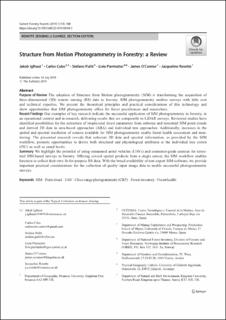| dc.contributor.author | Iglhaut, Jakob | |
| dc.contributor.author | Cabo, Carlos | |
| dc.contributor.author | Puliti, Stefano | |
| dc.contributor.author | Piermattei, Livia | |
| dc.contributor.author | O’Connor, James | |
| dc.contributor.author | Rosette, Jacqueline | |
| dc.date.accessioned | 2020-03-20T11:36:30Z | |
| dc.date.available | 2020-03-20T11:36:30Z | |
| dc.date.created | 2020-01-10T14:08:23Z | |
| dc.date.issued | 2019-07-16 | |
| dc.identifier.citation | Current Forestry Reports. 2019, 5 (3), 155-168. | en_US |
| dc.identifier.issn | 2198-6436 | |
| dc.identifier.uri | https://hdl.handle.net/11250/2647823 | |
| dc.description.abstract | Purpose of Review The adoption of Structure from Motion photogrammetry (SfM) is transforming the acquisition of three-dimensional (3D) remote sensing (RS) data in forestry. SfM photogrammetry enables surveys with little cost and technical expertise. We present the theoretical principles and practical considerations of this technology and show opportunities that SfM photogrammetry offers for forest practitioners and researchers. Recent Findings Our examples of key research indicate the successful application of SfM photogrammetry in forestry, in an operational context and in research, delivering results that are comparable to LiDAR surveys. Reviewed studies have identified possibilities for the extraction of biophysical forest parameters from airborne and terrestrial SfM point clouds and derived 2D data in area-based approaches (ABA) and individual tree approaches. Additionally, increases in the spatial and spectral resolution of sensors available for SfM photogrammetry enable forest health assessment and monitoring. The presented research reveals that coherent 3D data and spectral information, as provided by the SfM workflow, promote opportunities to derive both structural and physiological attributes at the individual tree crown (ITC) as well as stand levels. Summary We highlight the potential of using unmanned aerial vehicles (UAVs) and consumer-grade cameras for terrestrial SfM-based surveys in forestry. Offering several spatial products from a single sensor, the SfM workflow enables foresters to collect their own fit-for-purpose RS data. With the broad availability of non-expert SfM software, we provide important practical considerations for the collection of quality input image data to enable successful photogrammetric surveys. | en_US |
| dc.language.iso | eng | en_US |
| dc.rights | Navngivelse 4.0 Internasjonal | * |
| dc.rights.uri | http://creativecommons.org/licenses/by/4.0/deed.no | * |
| dc.subject | SfM | en_US |
| dc.subject | Pointcloud | en_US |
| dc.subject | UAV | en_US |
| dc.subject | Close-range photogrammetry (CRP) | en_US |
| dc.subject | Forest inventory | en_US |
| dc.subject | Forest health | en_US |
| dc.title | Structure from motion photogrammetry in forestry: a Review | en_US |
| dc.type | Peer reviewed | en_US |
| dc.type | Journal article | en_US |
| dc.description.version | publishedVersion | en_US |
| dc.rights.holder | The Author(s) 2019 | en_US |
| dc.subject.nsi | VDP::Landbruks- og Fiskerifag: 900 | en_US |
| dc.source.pagenumber | 155-168 | en_US |
| dc.source.volume | 5 | en_US |
| dc.source.journal | Current Forestry Reports | en_US |
| dc.source.issue | 3 | en_US |
| dc.identifier.doi | 10.1007/s40725-019-00094-3 | |
| dc.identifier.cristin | 1770368 | |
| cristin.unitcode | 7677,2,0,0 | |
| cristin.unitname | Divisjon for skog og utmark | |
| cristin.ispublished | true | |
| cristin.fulltext | original | |
| cristin.qualitycode | 1 | |

